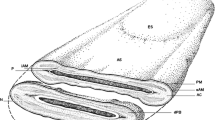Summary
Association of spermatozoa with blastomeres removed from the egg envelope was studied in order to investigate sperm membrane behavior under circumstances unlike those attending fertilization of normal envelope-enclosed eggs. Under the altered circumstances all parts of the surface of the sperm cell were afforded the opportunity of meeting blastomere plasma membrane. Nevertheless, in each case the spermatozoon first became activated, an acrosomal tubule formed, and it was this organelle alone which fused and established continuity with the blastomere plasma membrane. This behavior of the spermatozoon with respect to the denuded blastomere parallels the behavior of the sperm cell with respect to the envelope-enclosed egg at fertilization. Since the sperm cell behaves so similarly in two situations which are so different with respect to what the spermatozoon encounters, this behavior is considered to reflect the inherent nature of the spermatozoon, and analysis of this behavior in relation to a blastomere is considered to be valid also in relation to an egg during fertilization. It is concluded that membrane fusion, involving the acrosomal tubule of an activated spermatozoon, is the only means by which gametic union is established and that these are obligatory rather than fortuitous features of sperm-egg association in Saccoglossus. It is suggested that these features are probably obligatory also in other species which exhibit this pattern of sperm-egg association.
Similar content being viewed by others
References
Colwin, A. L., and L. H. Colwin: Fine structure studies of fertilization with special reference to the role of the acrosomal region of the spermatozoon during penetration of the egg (Hydroides hexagonus — Annelida), Symposium on the Germ Cells and Earliest Stages of Development, Institut Internat. d'Embryologie and Fondazione A. Baselli, Istituto Lombardo, p. 220–222, 1960.
—: Changes in the spermatozoon during fertilization in Hydroides hexagonus (Annelida). II. Incorporation with the egg. J. biophys. biochem. Cytol. 10, 255–274 (1961a).
—: Role of the gamete membranes in fertilization in Saccoglossus kowalevskii (Enteropneusta). I. The acrosomal region and its changes in early stages of fertilization. J. Cell Biol. 19, 477–500 (1963a).
—: Role of the gamete membranes in fertilization. In: Cellular Membranes in Development, 22nd Symposium of The Society for the Study of Development and Growth (M. Locke, ed.), p. 233–279. New York: Academic Press, 1964.
Colwin, L. H., and A. L. Colwin: Observations of sperm entry during re-fertilization in Saccoglossus kowalevskii (Enteropneusta). Biol. Bull. 113, 341 (1957).
—: Changes in the spermatozoon during fertilization in Hydroides hexagonus (Annelida). I. Passage of the acrosomal region through the vitelline membrane. J. biophys. biochem. Cytol. 10, 231–254 (1961b).
—: Induction of spawning in Saccoglossus kowalevskii (Enteropneusta) at Woods Hole. Biol. Bull. 123, 493 (1962).
—: Role of the gamete membranes in fertilization in Saccoglossus kowalevskii (Enteropneusta). II. Zygote formation by gamete membrane fusion. J. Cell Biol. 19, 501–518 (1963b).
—: Membrane fusion in relation to sperm-egg association, chapt. VII in Fertilization: Comparative Morphology, Biochemistry and Immunology (C. B. Metz and A. Monroy), eds.), p. 295–367. New York: Academic Press, 1967.
Harris, H., J. F. Watkins, C. E. Ford, and I. G. Schoefl: Artificial heterokaryons of animal cells from different species. J. Cell Sci. 1, 1–30 (1966).
Minganti, A.: Experiments on interspecific fertilization between Ciona, Styela and Molgula (ascidians). Biol. Bull. 123, 505 (1962).
Sugiyama, M.: Re-fertilization of the fertilized eggs of the sea-urchin. Biol. Bull. 101, 335–344 (1951).
Tyler, A., A. Monroy, and C. B. Metz: Fertilization of fertilized sea urchin eggs. Biol. Bull. 110, 184–195 (1956).
—, and J. Schultz: Inhibition and reversal of fertilization in the eggs of the echiuroid worm Urechis caupo. J. exp. Zool. 63, 509–530 (1932).
Venable, J. H., and R. J. Coggeshall: A simplified lead citrate stain for use in electron microscopy. J. Cell Biol. 25, 407–408 (1965).
Author information
Authors and Affiliations
Additional information
This investigation was supported by Research Grant HD-00007 from the National Institutes of Health, United States Public Health Service.
Rights and permissions
About this article
Cite this article
Colwin, A.L., Colwin, L.H. Behavior of the spermatozoon during sperm-blastomere fusion and its significance for fertilization (Saccoglossus kowalevskii: hemichordata). Z. Zellforsch. 78, 208–220 (1967). https://doi.org/10.1007/BF00334763
Received:
Published:
Issue Date:
DOI: https://doi.org/10.1007/BF00334763




